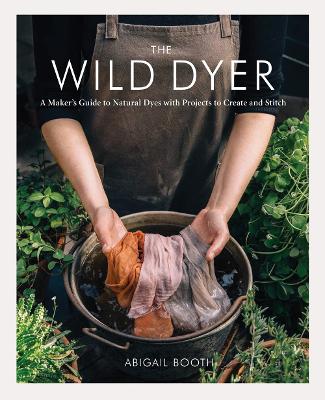Reviewed by annieb123 on
The Wild Dyer is a new tutorial guide for foraging and utilizing wild plants and other materials for dying by Abigail Booth. Originally published in the UK in 2017, this US release by Princeton Architectural Press, out 1st Oct 2019 is 160 pages and available in hardcover and ebook formats.
This book is an odd (but interesting) combination of dyeing, crafting (sewing), and foraging wild materials. The emphasis is on sourcing and using dye materials to produce textiles. The introductory chapters (~26% of the content) cover a little bit of color theory, sourcing and using dye materials, tools, and preparing and dyeing fabric. The author's process tutorials include basic instructions for sourcing, scouring, and mordanting techniques and supplies.
The rest of the book covers growing and harvesting materials from the garden, seasonal foraging, and a reference section including an herbal, glossary, resource list, and index.
This is a good resource for -experimentation- .... the author is very upfront about the variables in home dying being multitudinous and difficult to control. This book is quite suitable for exploring and learning alone or in a small workshop type setting. I don't think this book would be useful for crafters looking for a method to produce large quantities of finished fibre/fabric. Also, the colors resulting from the materials in the book are not uniform and some are muddy (i.e., don't expect clear, strong, modern, aniline dyes). This would be perfect for recreationists (SCA people), period re-enactors who are into authenticity and historical folks.
The projects included are basic and can be achieved by anyone; at least one (coasters) is hand-sewn, some of the others are done with a basic straight stitch machine. Some of the projects are of questionable practicality, but they're all earthy and attractive. I have some experience with textiles, including dyeing fabric with natural materials, and I'm intrigued by the author's instruction for using woad. Her process appears to emphasize minimizing oxygen exposure (it's a bit hazy in the book). I am intrigued because she suggests keeping the fermenting woad near a heat source such as a radiator. When I've used woad in the past, the powerfully unpleasant (nauseating) smell wouldn't be welcome in any home I could imagine.
Anyhow, experimentation is key here. There is a lot of good basic information. The photography is well done and abundant.
Four stars.
Disclosure: I received an ARC at no cost from the author/publisher for review purposes.
Reading updates
- Started reading
- Finished reading
- 21 October, 2019: Reviewed
